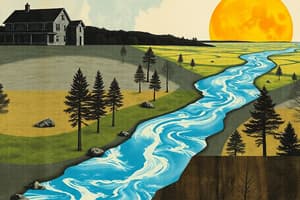Podcast
Questions and Answers
What is the main role of solar energy in the water cycle?
What is the main role of solar energy in the water cycle?
- It transforms ice into liquid water.
- It increases the weight of water vapor.
- It powers the evaporation of water into vapor. (correct)
- It cools the surface of water bodies.
Which process directly results in the formation of clouds?
Which process directly results in the formation of clouds?
- Transpiration from plants.
- Infiltration into the ground.
- Sublimation of snow.
- Condensation of water vapor. (correct)
What initiates the process of precipitation as rain?
What initiates the process of precipitation as rain?
- The mixing of air with water-laden fog.
- Colliding water-laden clouds due to wind movements. (correct)
- The evaporation of surface water in lakes.
- The accumulation of sublimated water vapor.
Which phenomenon allows snow to convert directly into water vapor?
Which phenomenon allows snow to convert directly into water vapor?
What can reduce the availability of groundwater aquifers?
What can reduce the availability of groundwater aquifers?
What type of precipitation forms when water vapor condenses into tiny droplets that remain airborne?
What type of precipitation forms when water vapor condenses into tiny droplets that remain airborne?
How does pollution often affect the water cycle?
How does pollution often affect the water cycle?
Which phase of the water cycle is directly impacted by the transpiration process?
Which phase of the water cycle is directly impacted by the transpiration process?
What role do plants play in the water cycle that is affected by deforestation?
What role do plants play in the water cycle that is affected by deforestation?
Which pollution type primarily disrupts the water cycle by introducing toxic contaminants into water bodies?
Which pollution type primarily disrupts the water cycle by introducing toxic contaminants into water bodies?
What is a direct consequence of deforestation on groundwater levels?
What is a direct consequence of deforestation on groundwater levels?
How does air pollution specifically affect the evaporation and condensation processes of the water cycle?
How does air pollution specifically affect the evaporation and condensation processes of the water cycle?
Which type of precipitation is most likely to be influenced by air pollution through the formation of smog?
Which type of precipitation is most likely to be influenced by air pollution through the formation of smog?
What is the process called when water vapor changes directly into frost and snow in extremely cold climates?
What is the process called when water vapor changes directly into frost and snow in extremely cold climates?
Which of the following actions can aid in the accumulation of underground water in aquifers?
Which of the following actions can aid in the accumulation of underground water in aquifers?
What role does evaporation play in the water cycle concerning sediment and dust particles?
What role does evaporation play in the water cycle concerning sediment and dust particles?
How does the water cycle contribute to the cooling effect on Earth?
How does the water cycle contribute to the cooling effect on Earth?
What effect does infiltration have on saline water bodies?
What effect does infiltration have on saline water bodies?
What is a key impact of precipitation on Earth's weather and climate?
What is a key impact of precipitation on Earth's weather and climate?
What is one major permanent water reserve on Earth?
What is one major permanent water reserve on Earth?
Which biogeochemical cycles are influenced by the water cycle?
Which biogeochemical cycles are influenced by the water cycle?
Flashcards are hidden until you start studying
Study Notes
Water Distribution and Movement
- Study of water's distribution and movement on Earth, including human impact on water availability.
- Focus on both surface and underground water conditions.
Water Cycle (Hydrologic Cycle)
- Continuous movement of water through solid, liquid, and gas phases.
- Sun is the primary energy source driving the water cycle.
- Bernard Palissy proposed the modern theory of the water cycle in 1580 CE.
Stages of the Water Cycle
- Evaporation: Water from oceans, lakes, and streams transforms into vapor due to sunlight.
- Transpiration: Plants release water vapor from leaves and stems into the atmosphere.
- Sublimation: Snow can directly change into vapor without becoming liquid due to conditions like dry wind and low humidity.
Condensation Process
- Water vapor in the atmosphere cools and transforms back into liquid, leading to cloud formation.
- Sudden temperature drops can create fog when vapor condenses into tiny water droplets mixed with dust.
Precipitation
- Wind causes cloud collisions resulting in rain, which replenishes Earth's water bodies.
- In cold climates, water vapor can deposit as frost or snow, leading to accumulation in higher altitudes.
Underground Water Movement
- Precipitated water infiltrates soil and rock layers, forming aquifers.
- Earthquakes can help underground water reach the surface.
- Volcanic eruptions mix underground water with surface water, continuing the cycle.
Key Impacts of the Water Cycle
- Provides fresh water for plants, animals, and humans through groundwater purification.
- Evenly distributes water across Earth's surfaces.
- Temporary cloud storage and permanent reserves include rivers and lakes.
- Evaporation causes a cooling effect, influencing weather and climate.
- Supports other biogeochemical cycles like those involving oxygen and phosphorus.
- Cleans the atmosphere by removing dust and bacteria, aiding air purification.
Human Impact on the Water Cycle
- Deforestation: Disrupts water cycle flow by reducing groundwater levels and hindering transpiration.
- Pollution: Air pollution from fossil fuels leads to smog and acid rain; agricultural runoff introduces chemicals, decreasing evaporation and condensation efficiency.
Studying That Suits You
Use AI to generate personalized quizzes and flashcards to suit your learning preferences.




